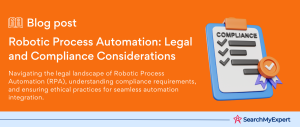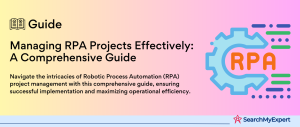Tackling SME Challenges with Robotic Process Automation
The Struggle of SMEs with Repetitive Tasks and Human Errors
Small and medium-sized enterprises (SMEs) often grapple with the dual challenge of repetitive tasks and human errors. These repetitive tasks, crucial yet time-consuming, can significantly drain resources, limiting the ability of SMEs to focus on growth and innovation. Human errors, on the other hand, can lead to inefficiencies, affecting both operational effectiveness and customer satisfaction. This situation underscores the need for a solution that can address these challenges efficiently.
Robotic Process Automation: A Brief Overview
Robotic Process Automation (RPA) is an innovative technology designed to automate routine, rule-based tasks. At its core, RPA involves the deployment of software robots or ‘bots’ that mimic human interactions with digital systems. These bots are capable of performing a wide range of functions, from simple data entry and form processing to more complex tasks like transaction processing and customer communication. The essence of RPA lies in its ability to handle repetitive tasks quickly, accurately, and without fatigue, thus offering a reliable and efficient automation solution.
The Significance of RPA for SMEs
For SMEs, RPA holds particular significance due to its numerous benefits:
- Increased Productivity:
By automating routine tasks, RPA frees up employees to focus on more strategic work. This shift not only enhances productivity but also fosters innovation and business growth. - Cost Savings:
RPA reduces the need for additional human resources for mundane tasks. It also minimizes the costs associated with human errors, such as rework and rectification, leading to significant cost savings for SMEs. - Improved Accuracy: One of the standout benefits of RPA is its precision. By eliminating human errors in repetitive tasks, RPA ensures a higher level of accuracy in operations, enhancing the overall quality and reliability of business processes.
Key Areas for RPA in SMEs
RPA offers a wealth of opportunities for SMEs across various business functions. Here’s a look at how it can be applied in different departments:
- Finance and Accounting:
In the finance department, RPA can automate tasks such as invoice processing, accounts payable and receivable, expense management, and financial reporting. Bots can extract data from invoices, match them with purchase orders, and enter this data into accounting systems. - Human Resources:
HR processes like employee onboarding, payroll processing, and leave management are ideal for RPA. Bots can handle data entry tasks associated with new hires, calculate payroll based on time sheets, and manage leave requests and balances. - Customer Service:
RPA can significantly enhance customer service efficiency by automating tasks like ticket generation, customer query responses, and feedback collection. Bots can quickly sift through customer inquiries and route them to the appropriate department or provide automated responses for common queries. - Operations:
Operations can benefit from RPA in inventory management, order processing, and shipment tracking. Bots can update inventory levels, process orders by extracting information from order forms, and update tracking systems with shipment details.
Selection Criteria for Automating Processes
When selecting processes for RPA implementation, SMEs should consider the following factors:
- Frequency: High-frequency tasks that occur daily or weekly are prime candidates for automation.
- Complexity:
Processes that are time-consuming but follow a set pattern or rules are suitable for RPA. - Rule-Based Nature:
Tasks that are rule-based and don’t require human judgment or decision-making are ideal for RPA. - Data Intensive: Processes that involve handling large volumes of data can benefit greatly from RPA.
- Error-Prone: Tasks that are prone to human error due to their repetitive nature are also good candidates for automation.
Real-Life Examples of RPA in SMEs
- Finance Sector SME:
A small financial services firm automated its invoice processing using RPA. Previously, employees spent hours manually entering data from invoices into their accounting software. With RPA, this task is completed automatically, reducing processing time by 70% and virtually eliminating data entry errors. - Retail Business:
A retail SME implemented RPA for managing its inventory and order processing. The bots automatically update inventory levels based on sales data and process incoming orders by extracting information from order forms, significantly speeding up operations and reducing manual workload. - HR in a Tech SME:
An IT company automated its employee onboarding process using RPA. The bot gathers data from new hire forms, sets up accounts in various systems, and schedules orientation sessions, reducing the onboarding process time from a week to a single day.
Different Approaches to RPA Implementation in SMEs
When implementing RPA in an SME, there are several approaches to consider, each with its unique advantages and challenges:
In-House Development:
- This approach involves building an internal team to develop and manage RPA bots.
- Pros: Complete control over the development process, customization to specific business needs, and building internal RPA expertise.
- Cons: Requires investment in hiring and training personnel skilled in RPA, and might be more time-consuming.
Cloud-Based Solutions:
- Cloud-based RPA solutions offer RPA capabilities as a service, with bots hosted in the cloud.
- Pros:
Lower upfront costs, scalability, and ease of access without the need for extensive infrastructure. - Cons: Dependence on the service provider for reliability and security, and potential limitations in customization.
Managed Service Providers (MSPs):
- Partnering with MSPs who specialize in RPA allows SMEs to outsource the entire RPA process.
- Pros:
Access to expert knowledge and resources, reduced time to implementation, and lower initial investment in expertise and technology. - Cons: Higher long-term costs and less direct control over the automation processes.
Cost Considerations in RPA Implementation
Several cost factors must be taken into account for a successful RPA implementation:
- Software Licenses:
Depending on the chosen approach, costs can vary from one-time purchases to ongoing subscription fees. - Training: Investing in employee training is crucial, especially for in-house development. This includes training for both the IT team and end-users.
- Ongoing Maintenance and Support:
Regular maintenance is required to ensure the smooth functioning of RPA bots, including software updates, monitoring, and troubleshooting. - Initial Setup and Integration Costs: Costs associated with setting up the RPA system and integrating it with existing IT infrastructure and applications.
Preparing Your Team for RPA
Employee buy-in is essential for the successful implementation of RPA:
- Communicate the Benefits:
Clearly communicate how RPA will benefit the business and the employees, emphasizing improvements in efficiency and the reduction of mundane tasks. - Training and Education:
Provide comprehensive training and educational resources to help employees understand and adapt to the new technology. - Addressing Resistance to Change:
Acknowledge concerns and resistance to change. Offer reassurances about job security and highlight opportunities for upskilling and engaging in more meaningful work. - Involvement in the Process: Involve employees in the implementation process, seeking their input and feedback. This inclusion helps in building a sense of ownership and acceptance.
Overview of Popular RPA Software
Several RPA tools have gained prominence in the market, each offering unique features and functionalities catering to various business needs:
- UiPath:
Known for its user-friendly interface and extensive library of pre-built activities. It is suitable for both simple and complex workflows and offers strong community support and training resources. - Automation Anywhere:
Offers a cloud-native platform with a strong emphasis on AI and machine learning integration. It is known for its ease of use and robust analytics capabilities. - Blue Prism: Targets more complex RPA needs and is known for its enterprise-grade security and scalability. It’s particularly favored for processes requiring significant integration with existing systems.
- Microsoft Power Automate (formerly Microsoft Flow): Integrated well with other Microsoft products and services, it’s ideal for SMEs already using the Microsoft ecosystem. It offers both cloud-based and on-premises deployment options.
- Pega Robotic Automation:
Known for its advanced AI capabilities and is typically used for more complex, enterprise-level automation tasks.
Comparing Different RPA Tools
When comparing RPA tools, SMEs should consider the following factors:
- Ease of Use: Look for user-friendly interfaces and intuitive design, which reduce the learning curve and allow for quicker deployment.
- Scalability:
Assess whether the tool can scale according to business growth and handle increasing or fluctuating automation demands. - Integration Capabilities:
Ensure the tool can seamlessly integrate with existing business systems and applications, such as ERP, CRM, and HRM software. - Pricing Models:
Understand the pricing structure of each tool. Some may offer subscription-based models, while others might have one-time purchase costs or charges based on the number of bots. - Support and Training:
Check the availability and quality of customer support and training resources, which are crucial for successful implementation and ongoing maintenance. - Security Features:
Given the sensitive nature of business processes, evaluate the security measures and compliance standards supported by the RPA tool.
Demo and Pilot Testing
Before fully committing to an RPA tool, it’s advisable to conduct demo and pilot testing:
- Request Demonstrations:
Most RPA tool providers offer free demonstrations. Use these demos to get a feel for the software’s interface and functionalities. - Pilot Projects:
Start with a pilot project on a small scale to test the tool in a real-world business scenario. Choose a process that is representative of the larger tasks you plan to automate. - Evaluate Performance:
During the pilot, evaluate the tool’s performance, ease of use, and compatibility with existing systems. Also, assess the impact on workflow and any efficiency improvements. - Gather Feedback:
Collect feedback from the employees who interact with the RPA tool during the pilot. Their insights can be invaluable in deciding whether to proceed with full-scale implementation.
Process Mapping and Analysis
Before diving into the automation of tasks using RPA, it’s crucial to have a clear understanding and documentation of the existing processes. This step is known as process mapping and analysis.
- Understanding Current Processes:
This involves a detailed examination of the current workflow, identifying each step and the responsible parties. Understanding the flow, bottlenecks, and inconsistencies in the existing process is vital. - Documentation:
Documenting the process provides a blueprint for automation. It should include every step, decision points, inputs, and outputs. This documentation serves as a reference for developing the RPA bot. - Identifying Automation Opportunities:
Through this analysis, you can pinpoint which parts of the process are best suited for automation. Ideal tasks for RPA are those that are rule-based, repetitive, prone to human error, and time-consuming.
Bot Development
The development of RPA bots involves several steps:
- Designing the Bot:
Based on the process analysis, design the bot’s workflow. This includes mapping out each action the bot needs to perform. - Recording User Actions: Many RPA tools offer a recording feature where a user’s actions on their computer are recorded to create a bot script. This script is then fine-tuned to ensure accuracy.
- Defining Rules and Parameters:
Set up the rules and parameters the bot must follow. This includes conditions for decision-making within the process and ensuring the bot can handle different scenarios and exceptions. - Integration with Systems: Ensure the bot can integrate seamlessly with the existing IT infrastructure, such as databases, CRM systems, and other applications.
Testing and Optimization
Thorough testing is a non-negotiable part of deploying RPA bots:
- Initial Testing:
After the bot is developed, it undergoes initial testing in a controlled environment to ensure it performs as intended. - Integration Testing:
Test the bot in conjunction with the systems and processes it will interact with. This ensures that the bot works well within the existing IT ecosystem. - User Acceptance Testing (UAT):
Allow end-users to test the bot in real-world scenarios. Their feedback is crucial in identifying any issues and making the user experience as smooth as possible. - Continuous Optimization: Post-deployment, continuously monitor the bot’s performance and make necessary adjustments. Optimization is an ongoing process, as business processes and environments are dynamic.
Expanding Automation Across the Business
As SMEs gain confidence and experience with RPA, they can look to expand automation across more processes and departments:
- Gradual Expansion:
Start with automating processes in one department and gradually expand to others, leveraging the learnings and successes from initial implementations. - Cross-Departmental Assessment:
Evaluate processes in other departments for automation potential. Look for tasks that are repetitive, rule-based, and time-intensive, similar to those successfully automated in the initial phase. - Prioritizing High-Value Processes:
Focus on automating processes that could yield the highest value in terms of cost savings, efficiency, or customer satisfaction. - Employee Involvement:
Engage employees from different departments to identify automation opportunities and provide insights into department-specific processes.
Performance Monitoring and Analytics
Ongoing tracking and analysis of RPA performance are essential for continuous improvement:
- Establish Key Performance Indicators (KPIs):
Set up KPIs to measure the performance of RPA bots. These could include metrics like processing time, error rates, and cost savings. - Regular Reviews:
Conduct regular reviews of RPA performance against these KPIs. This helps in identifying areas where bots are performing well and areas needing improvement. - Feedback Loop:
Incorporate feedback from users and IT staff to understand the real-world performance of bots and make adjustments as necessary. - Analytics for Optimization: Use analytics tools to gather insights from RPA operations. This data can guide strategic decisions on where to focus future automation efforts.
Future Trends and Advancements in RPA
The field of RPA is continuously evolving, with several future trends and advancements on the horizon:
- Integration with Artificial Intelligence (AI):
Combining RPA with AI and machine learning algorithms will enable bots to handle more complex, decision-based tasks. - Enhanced Cognitive Capabilities:
Future RPA tools are likely to feature enhanced cognitive capabilities, such as natural language processing, to automate a wider range of tasks. - Greater Accessibility and Usability:
Continued efforts to make RPA tools more user-friendly and accessible, allowing SMEs with limited technical expertise to implement automation more easily. - Predictive Analytics and Insights:
Advanced RPA systems may offer predictive analytics, providing businesses with foresight into potential issues or opportunities for further efficiencies.
Harness the Power of RPA for Your SME
Reaping the Rewards of RPA: A Game-Changer for SMEs
Unleashing Efficiency and Growth with Robotic Process Automation
Robotic Process Automation (RPA) isn’t just a buzzword; it’s a revolution in how Small and Medium-sized Enterprises (SMEs) operate. As we journey through this digital era, the importance of RPA in transforming businesses cannot be overstated. Here’s a recap of the phenomenal benefits of RPA for SMEs:
- Streamlining Operations:
RPA simplifies complex processes. It’s like having a digital workforce that works tirelessly, ensuring operations run smoothly and efficiently. - Cost Reduction:
Automating routine tasks cuts down on manual labor costs. It’s about doing more with less – maximizing output while minimizing expenses. - Enhanced Accuracy:
Say goodbye to human errors. RPA brings a level of precision that only a programmed machine can offer, enhancing the quality of work. - Scalability:
As your business grows, RPA adapts. It’s scalable, making it easier to expand operations without the proportional increase in costs or resources. - Data Management and Analytics:
RPA tools can gather and analyze data, providing valuable insights that drive informed decision-making. - Customer Satisfaction: Improved efficiency and accuracy lead to better customer experiences. Happy customers mean repeat business and glowing recommendations.
- Competitive Edge: In a world where speed and efficiency are king, RPA gives SMEs an edge over competitors still relying on traditional methods.
Take the Leap: Embrace RPA for Business Transformation
Now is the time for action. RPA is not a futuristic concept; it’s a present-day tool ready to elevate your business. Consider these steps to start your RPA journey:
- Assess Your Needs:
Identify processes in your business that are ripe for automation. - Choose the Right Partner:
Find an RPA provider that understands your specific business needs and offers solutions tailored to your goals. - Start Small, Think Big:
Begin with automating a single process. Once you see the benefits, expand your RPA strategy to other areas. - Educate Your Team:
Ensure your staff understands the value of RPA and how it complements their roles, rather than replacing them. - Monitor and Adapt:
Continuously review the performance of your RPA solutions and make adjustments as needed for optimal results.
Conclusion
Embracing RPA is not just about keeping up with technology; it’s about staying ahead in the business game. It’s an opportunity to transform your SME into a more efficient, agile, and competitive entity. The future belongs to those who innovate and adapt, and RPA is your ticket to that future.
Elevate your digital game with Robotic Process Automation Service Companies.
Table of Contents
Toggle






